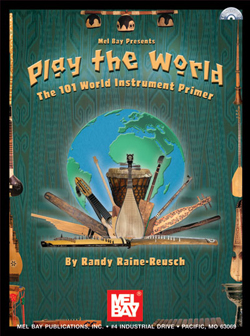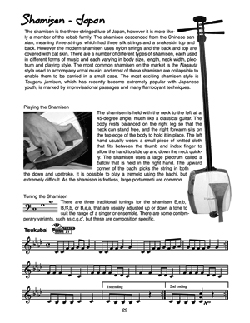|
|
|
| Play The World, The 101 World Instrument Primer - by Randy Raine-Reusch |

|
|
Play The World is the first and only world instrument primer featuring information on how to play 101 of the most popular and unique musical instruments from cultures around the world. There are large pictures of every instrument from the ahoco of the Ivory Coast to the zheng of China, complete with detailed playing instructions, tunings, and important idiosyncratic techniques. The enclosed CD includes a performance of every instrument. with accompanying notation in the text. This is an invaluable book for any musical world traveler.
- The first and only 101 World Instrument Primer.
- Pictures and description of 101 unique instrument from around the world.
- Includes tunings, playing instructions, special technique and a piece per instrument.
- Accompanying CD has a recording of each instrument.
Instruments included:
- Fiddles and Bowed Rebabs
- Erhu - China
- Goge - West Africa
- Koni - Vietnam
- Rebab - Indonesia
- Sarinda - Nepal
- Harps, Lyres and Harp-Lutes
- Ekidongo, Ennenga, Adungu - Uganda
- Nyatiti - Kenya
- Saung Gauk - Burma (Myanmar)
- Lutes and Plucked Rebabs
- Biwa - Japan
- Charango - Peru, Bolivia
- Dombra - Kazakhstan, Russia
- Dutar - Uyghurstan, Western China
- Gimbri, Guimbri, or Sintir - Morocco
- Oud or Ud - Middle East
- Pipa - China
- Rebab - Afghanistan
- Ruan - China
- Sapeh - Malaysia
- Saz or Baglama - Turkey
- Seung - Thailand
- Shamisen - Japan
- Sitar - India
- Tambura - India
- Tanbur - Uyghurstan, Western China
- Tar - Iran (Persia)
- Zithers
- Ajaeng - Korea
- Bro - Vietnam
- Chake - Thailand
- Citera - Hungary
- Dan Bau - Vietnam
- Dan Tranh - Vietnam
- Ichigenkin and Nigenkin - Japan
- Kacapi and Siter - Indonesia
- Kayagum - Korea
- Koto - Japan
- Lutong - Malaysia
- Mvet - Cameroon
- Pin Pia - Thailand
- Santur - Iran (Persia)
- Toba or Hanhye - Benin
- Valiha - Madagascar
- Zheng - China
- Flutes
- Dizi - China
- Fujara - Slovakia
- Maceño, Mohoceño, Moseno - Bolivia
- Ney or Nay - Middle East
- Ohe Hano Ihu - Hawaii
- Plains Flute - North America
- Quena - South America
- Selingut - Malaysia
- Seljefløyte - Norway
- Shakuhachi - Japan
- Suling - Indonesia
- Tarka - Chile, Bolivia
- Wot - Thailand
- Xun - China
- Zampoña, zamponia - Peru, Chile, Bolivia
- Free Reeds
- Bawu - China
- Hulusi - China
- Keluri - Sarawak, Malaysia
- Khaen - Thailand
- Naw - Thailand
- Sheng - China
- Sumpoton - Sabah, Malaysia
- Horns
- Didjeridu - Australia
- Dung Chen - Tibet
- Pu, Dung, or Conch - Polynesia, Tibet, India
- Reeds
- Duduk - Armenia
- Guanzi and Bili - China
- Midjweh and Arghul - Egypt
- Pungi or Bin - India
- Suona - China
- Drums, Balafons, Rattles, Scrapers
- Ahoco - Ivory Coast
- Aslatua, Kashaka, or Televi - Ghana
- Balofon - West Africa
- Bendir, Dap, Def - Eurasia
- Bodhran - Ireland
- Bones - Quebec, Canada
- Cabasa - Brazil
- Cajon - Peru, Cuba
- Changgo - Korea
- Djembe - West Africa
- Dumbek or Darabuka - Middle East
- Ektara or Gopiyantra - India, Bangladesh
- Kayamba - Kenya
- Komok or Anadalahari - India, Bangladesh
- Oyo - Nigeria
- Pandeiro - Brazil
- Senh Tien or Sinh Tien - Vietnam
- Shekere - Uganda
- Then - Vietnam
- Udu - Nigeria
- Jaw Harps or Jews Harps
- Genggong - Bali
- Kouqin - China
- Kubing and Giwong - Philippines
- Musical Bows
- Berimbau - Brazil
- Chipendani or Umrhubhe - South Africa
- Other
- Kalimba - Eastern and Central Africa
- Mbira - Zimbabwe, South Africa
- Musical Glasses, Glass Harmonica - Europe
- Musical Saw - United States, Sweden
|

Sample |
| |

